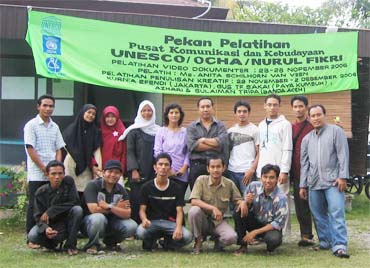When a video camera is no longer a strange thing for an Acehnese
12-12-2006 (Jakarta)
A professional video camera was once used to be a strange thing for Hanum, a young female university student from Banda Aceh, Indonesia. Let alone various other devices related to camera that are usually used by professionals to produce video documentary. But now those equipments are no longer something strange to Hanum.
“Before, I understood nothing at all about video production. But through this training workshop I have acquired a very useful skill for the empowerment of myself in particular, and the people of Aceh in general,” she said with a happy voice and face, referring to the basic training on video production that she just completed.
The training was organized by UNESCO’s office in Jakarta from 23 to 28 November 2006 in Banda Aceh, , using funds donated by Switzerland through a direct fund raising efforts made by UNESCO Headquarters in Paris, in the aftermath of the tsunami that hit Aceh in December 2004. The training was held at the Communication and Cultural Centre (CCC) in Banda Aceh that was established in June by UNESCO Jakarta with support from UN OCHA’s flash appeal funds for tsunami.
The main objective of the training was to provide the participants with basic skills on documentary video production, so that they can utilize the skills to produce documentary on the richness of Aceh culture and the resilience of its people to face challenges, including the tsunami, that can be used as cultural expression.
Hanum now can play with the camera, and use it to shot subjects that interest her. She finds the training was very useful. And she was not alone in enjoying the usefulness of the training. There were 11 other participants, most of them university students, who were selected to join the training. The news on the training was announced through Radio Nikoya, which was destroyed by the tsunami but rebuilt with UNESCO’s assistance.
“I am so pleased too to see the enthusiam of the participants during the training, and how fast they learned about something completely new to them,” said the trainer, Anita Schillhorn Van Veen.
The two documentaries that the trainees produced during their training were screened at the CCC on the final night which received a warm welcome by the audience; some of them were ordinary people living nearby. There is another good news: their works are also invited to be screened in a Documentary Film Festival that will be held in Yogyakarta, mid December 2006.
“We hope this training will continue with an advance one,” says Mahruza Murdani, one of the participants who also joined the selected group for Training for Trainer session.
The training was organized by UNESCO’s office in Jakarta from 23 to 28 November 2006 in Banda Aceh, , using funds donated by Switzerland through a direct fund raising efforts made by UNESCO Headquarters in Paris, in the aftermath of the tsunami that hit Aceh in December 2004. The training was held at the Communication and Cultural Centre (CCC) in Banda Aceh that was established in June by UNESCO Jakarta with support from UN OCHA’s flash appeal funds for tsunami.
The main objective of the training was to provide the participants with basic skills on documentary video production, so that they can utilize the skills to produce documentary on the richness of Aceh culture and the resilience of its people to face challenges, including the tsunami, that can be used as cultural expression.
Hanum now can play with the camera, and use it to shot subjects that interest her. She finds the training was very useful. And she was not alone in enjoying the usefulness of the training. There were 11 other participants, most of them university students, who were selected to join the training. The news on the training was announced through Radio Nikoya, which was destroyed by the tsunami but rebuilt with UNESCO’s assistance.
“I am so pleased too to see the enthusiam of the participants during the training, and how fast they learned about something completely new to them,” said the trainer, Anita Schillhorn Van Veen.
The two documentaries that the trainees produced during their training were screened at the CCC on the final night which received a warm welcome by the audience; some of them were ordinary people living nearby. There is another good news: their works are also invited to be screened in a Documentary Film Festival that will be held in Yogyakarta, mid December 2006.
“We hope this training will continue with an advance one,” says Mahruza Murdani, one of the participants who also joined the selected group for Training for Trainer session.
 Participants of the documentary video training at UNESCO-UNOCHA's Communication and Cultural Centre in Banda Aceh
Participants of the documentary video training at UNESCO-UNOCHA's Communication and Cultural Centre in Banda Aceh© Arya Gunawan
Related themes/countries
· Indonesia
· Capacity Building: News Archives 2006
· Training of Media Professionals: News Archives 2006
· Creative Content: News Archives 2006
Share this story:
Contact information
- UNESCO Office Jakarta
Source














